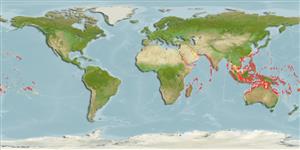Environment: milieu / climate zone / depth range / distribution range
Ecología
marino asociado a arrecife; rango de profundidad 3 - 50 m (Ref. 30874). Tropical; 30°N - 32°S
Indo-Pacific: Red Sea to Durban, South Africa (Ref. 4329) and to the Line and Tuamoto islands, north to Ryukyu Islands, south to New South Wales, Australia.
Tamaño / Peso / Age
Maturity: Lm ? range ? - ? cm
Max length : 11.0 cm TL macho / no sexado; (Ref. 68964)
Espinas dorsales (total): 8; Radios blandos dorsales (total): 9; Espinas anales 2; Radios blandos anales: 8. A small to near pupil-sized (Ref. 48635) basicaudal spot is centered at the level of the lateral stripe (Ref. 37816). Its lower edge at level with the lower ray of the central two rays in the caudal fin. The spot is usually absent in deep water or at night and often fades in the afternoon (Ref. 48635).
Found in relatively clear waters on reef flats and lagoon and seaward reefs to a depth of at least 25 m. Cryptic under ledges by day, singly or in small groups (Ref. 1602, 48635). Feeds on small invertebrates (Ref. 89972). Minimum depth range reported taken from Ref. 11890. Frequent at base of coral heads or under ledges (Ref 90102).
Life cycle and mating behavior
Madurez | Reproducción | Puesta | Huevos | Fecundidad | Larva
Mouthbrooders (Ref. 240). Distinct pairing during courtship and spawning (Ref. 205).
Myers, R.F., 1991. Micronesian reef fishes. Second Ed. Coral Graphics, Barrigada, Guam. 298 p. (Ref. 1602)
IUCN Red List Status (Ref. 130435)
Threat to humans
Harmless
Human uses
Pesquerías: sin interés
Más información
ReferenciasAcuiculturaPerfil de acuiculturaRazasGenéticaElectrophoresesheritabilidadEnfermedadesProcesamientoNutrientsMass conversion
Herramientas
Special reports
Download XML
Fuentes de Internet
Estimates based on models
Preferred temperature (Ref.
123201): 24.9 - 29.1, mean 27.6 °C (based on 730 cells).
Phylogenetic diversity index (Ref.
82804): PD
50 = 0.5312 [Uniqueness, from 0.5 = low to 2.0 = high].
Bayesian length-weight: a=0.01175 (0.00702 - 0.01965), b=3.07 (2.92 - 3.22), in cm total length, based on LWR estimates for this species & (Sub)family-body (Ref.
93245).
Nivel trófico (Ref.
69278): 3.5 ±0.50 se; based on food items.
Resiliencia (Ref.
120179): Alto, población duplicada en un tiempo mínimo inferior a 15 meses (Preliminary K or Fecundity.).
Fishing Vulnerability (Ref.
59153): Low vulnerability (10 of 100).
Nutrients (Ref.
124155): Calcium = 130 [66, 211] mg/100g; Iron = 0.934 [0.542, 1.602] mg/100g; Protein = 18.6 [17.4, 19.8] %; Omega3 = 0.135 [0.078, 0.232] g/100g; Selenium = 34.4 [17.8, 66.4] μg/100g; VitaminA = 56.9 [16.4, 199.3] μg/100g; Zinc = 1.59 [1.05, 2.33] mg/100g (wet weight);
